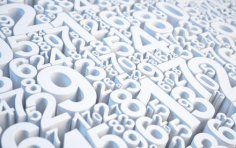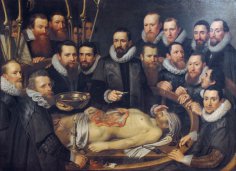
Everything is number! So said ancient thinkers, linking philosophy with mathematics, raising the question of the numerical structure of the universe, where mathematics was combined with theology, and theology flowed from mathematics. But first, we must clarify how humans began counting and when the primary counting system emerged, which is the symbolic method of recording numbers and representing them using written symbols.
Almost all scientists agree that the primary counting system was finger counting. However, researchers disagree on how this counting was accomplished.
Fingers and toes gave humans their first numerical sequence, which they still use today, using their fingers to indicate the desired number from 1 to 5, and less commonly, up to 10. The media has reported numerous variations of manual counting, known as binary, quinary, duodecimal, twentieth, and other number systems. It is believed that mathematical calculations were performed by humans using the flexion, extension, and pointing of their fingers, and sometimes even their toes.
Variations of counting with four fingers, without the thumb, are proposed, claiming this is an ancient octal system (?). In some cases, you have to touch the tip of the thumb to the phalanges of the fingers to indicate counting. Numerous ways of folding the fingers into complex configurations are shown, similar to yogic “mudras,” where folding the fingers into a figure like a “fig” probably depicts—nothing. There's a counting system involving clenching the fingers into a fist, and many similar ones.
There are references in the media to manual, pictographic counting using crossed hands to indicate tens. It is also said that the earliest mention of a decimal system of finger counting in literature is found in Publius Ovidius Naso's book “Fasti,” in which the author depicted the ancient Roman concept of the number of fingers, which was associated with the ten lunar months of a woman's pregnancy.
It seems that to convey any numbers, a person had to not only perform various finger movements, shaking their hands, clenching and unclenching their fists. They also had to dance along with it, to show off their toes, with some kind of quirk, because, it turns out, there was also bodily counting. And presumably, the other person had to do the same in response. Although, to indicate a number, simply stating it, without any gestures, was enough.
All of this can be boiled down to this: ancient Paleolithic humans needed only two fingers to count two carrots and share one with a friend. Bushmen, even today, count to only three or four. Social humans needed the fingers of both hands to communicate information to a larger number of people, and then this counting had to be recorded on existing media. This is where symbols with variations of human hands may have been written.
Scholars point to the phenomenon of ancient science, believing that it was then that the model of theoretical thinking, represented by ancient philosophers in logic and dialectics, was formed. It was then that humans learned to figuratively represent matter, uniting many individual elements into a single whole, representing them as a set of numbers in the form of signs and symbols. These later transformed into positional numeral systems such as Arabic and Roman.
The first symbols that scholars associated with a quinary numeral system were discovered on cult objects associated with funerary rites. These symbols, discovered on bronze “sickles” from the early period of the Central European Urnfield culture, are interpreted as primitive numerals around 1200–1500 BCE. Based on the ////\\\\\ signs found on the sickles, it has been suggested that this is a quinary counting system linked to the lunar cycle.
A leftward-slanting slash was considered to be 1 (one), and a rightward-slanting slash was considered to be 5 (five), or vice versa, resulting in a maximum of 29—the number of days in the lunar calendar. Similar symbols found on cultural artifacts have been partially interpreted as numerals (numbers) and have not yet been fully deciphered. Whether this is true or not, it brings to mind Ovid and his Fasti, with their mention of pregnancies, which are usually calculated according to the lunar calendar.
I believe that the given composition ////\\\\\ is related not only to the calculations of the lunar calendar (if this is so), but also to the construction of the first primitive counting system, and then to the creation of the Roman numeral series – I, II, III, IIII, V, VI, VII, VIII, VIIII, X, which was derived by the ancient Greeks, using their method of deciphering ancient symbols.
Like all ingenious inventions, the first primitive counting system was created in the most basic way: by an inquisitive person on all fours, leaving double footprints in the sand, with thumbs joined. The double palm print with thumbs extended ||||/\|||| will represent the first primitive counting system and the first image of the Roman numeral system.
Adherents of the primitive numeracy, seeking self-knowledge, may have experimented with the marks left in the sand by their own hands. If you connect your fingers together, you'll get a line of symbols—////\\\\\—found on bronze ritual sickles of the proto-Celts. Here, lovers of modern fantasy might suggest that these symbols present in burials are identifiers of the ashes “rested” in the urn, as fingerprints are always individual.
And if we connect our thumbs in a straight line in this formation, we get this sign system: ////_\\\\ – representing a triangle. Or we could draw a rhombus, because there's no limit to perfection!





